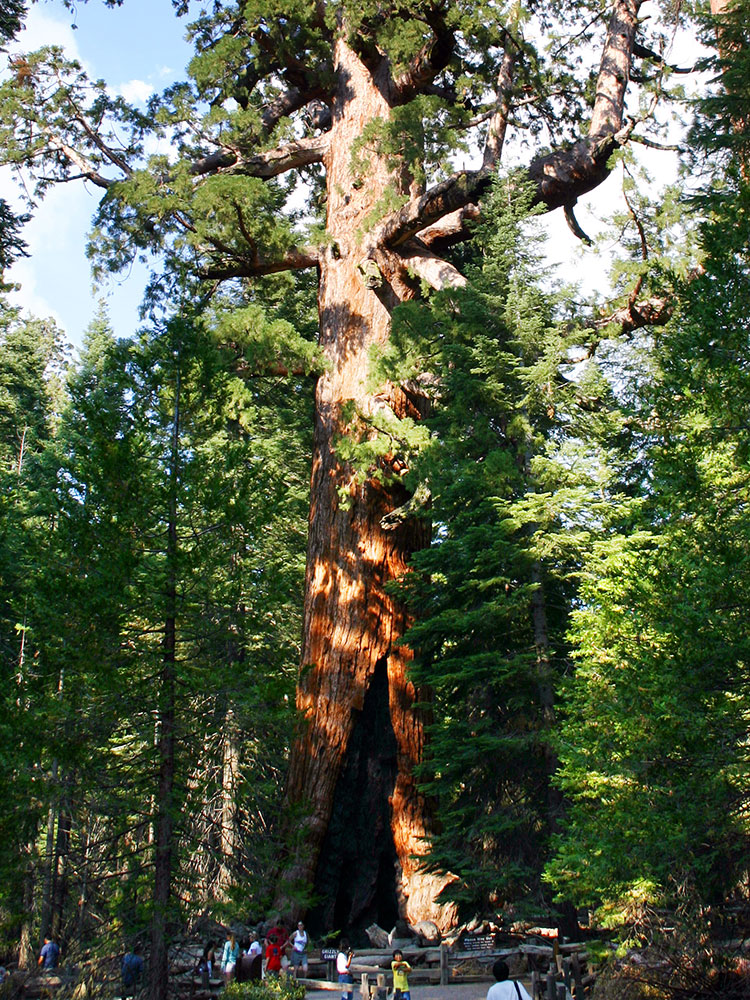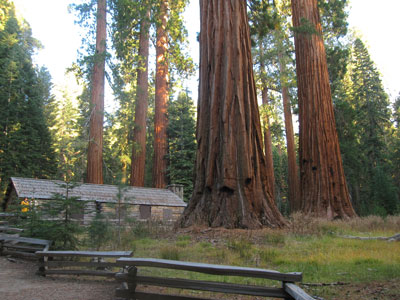Largest grove of giant sequoias in the park, with several hundred mature examples of the tree. Two of its trees are among the 30 largest giant sequoias in the world
From Yosemite Valley El Portal Entrance (39 mi): Take El Portal Rd to Mariposa Grv Rd/Wawona Rd. At the traffic circle, take the 2nd exit onto Mariposa Grv Rd/Wawona Rd.
Overview
Mariposa Grove is a sequoia grove located near Wawona, California, in the southernmost part of Yosemite National Park. It is the largest grove of giant sequoias in the park, with several hundred mature examples of the tree. Two of its trees are among the 30 largest giant sequoias in the world.
The Mariposa Grove was first visited by non-natives in 1857 when Galen Clark and Milton Mann found it. They named the grove after Mariposa County, California, where the grove is located.

Located in the southern portion of Yosemite, the Mariposa Grove of Giant Sequoias is the largest sequoia grove in Yosemite and is home to over 500 mature giant sequoias. The national park idea is rooted in the Mariposa Grove. In 1864 President Lincoln signed legislation protecting the Mariposa Grove and Yosemite Valley for "public use, resort, and recreation." This landmark legislation holds an important place in our country's history and was enacted at a time when the nation was embroiled in the Civil War. For the first time in our nation's history, the federal government set aside scenic natural areas to be protected for the benefit of future generations. Later added to Yosemite National Park in 1906, the Mariposa Grove is a popular destination within the park.
Access
Access to the grove is via a four-mile round-trip hike with 500 feet of elevation change. It's an additional 1.5 miles round trip (and another 500 feet of elevation change) to the Grizzly Giant and California Tunnel Tree. Please bring water to keep everyone in your group hydrated (there is no drinking water available in the Mariposa Grove).
The Mariposa Grove Welcome Plaza (near South Entrance) will have flush toilets and drinking water. The Mariposa Grove Arrival Area will have portable toilets and no drinking water.
The main trail to the Grizzly Giant will be closed due to storm damage, but hikers can use the service road to reach the Grizzly Giant. While all other trails are open, hikers may encounter downed trees.
Getting to the Mariposa Grove
There is currently no free shuttle from the Mariposa Grove Welcome Plaza to the Mariposa Grove. Parking is available (until full) at the Mariposa Grove Welcome Plaza. There are approximately 300 parking spaces and it may fill by mid-morning. Access to Mariposa Grove is via a two-mile hike (each way) on the Washburn Trail or the Mariposa Grove Road (each have approximately 500 feet in elevation gain). Several miles of trails are available in the grove from that point.
Mariposa Grove Museum
The Mariposa Grove Museum, also known as the Mariposa Grove Cabin, is a large cabin that was built in 1930. The cabin sits in the shadow of two prominent giant sequoia trees: General Grant and General Sheridan. It was listed on the National Register of Historic Places in 1978. The museum features numerous historic photographs and details the history of Mariposa Grove.
The giant sequoia named Grizzly Giant is between probably 1900-2400 years old: the oldest tree in the grove. It has a volume of 34,010 cubic feet (963 m3), and is counted as the 25th largest tree in the world. It is 210 feet (64 m) tall, and has a heavily buttressed base with a basal circumference of 28 m (92 ft) or a diameter of 30 feet (9.1 m); above the buttresses at 2.4 m above ground, the circumference is only 23 m. Grizzly Giant's first branch from the base is 2 m (6 ft) in diameter. Another tree, the Wawona Tree, had a tunnel cut through it in the nineteenth century that was wide enough for horse-drawn carriages and early automobiles to drive through. Weakened by the large opening at its base, the tree fell down in a storm in 1969.
Noteworthy trees
Some of the trees found in the grove that are worthy of special note are:
- The Fallen Monarch: A giant sequoia that fell more than three hundred years ago. Giant sequoias are resistant to decay, so their remains can linger for a long period of time if undisturbed.
- The Bachelor and Three Graces: A group of four giant sequoias, three of them growing very close together, with a fourth a little more distant. Their roots are so intertwined that if one of them were to fall, it would likely bring the others along with it.
- The Grizzly Giant: The oldest tree and second largest tree in the grove, with a volume of 34,010 cubic feet (963 m3).
- The Washington tree: The largest tree in the grove, with a volume of 35,950 cubic feet (1,018 m3).
- The General Sheridan tree: A large, 286 feet (87 m) tall giant sequoia located south of the Mariposa Grove Cabin.
- The General Grant tree: A large giant sequoia located west of the Mariposa Grove Cabin. Not to be confused with the General Grant Tree of Sequoia National Park.
- The Columbia tree: The tallest tree in the grove and in Yosemite National Park at 286 feet (87 m).
- The California Tunnel Tree: Cut in 1895 to allow coaches to pass through it (and as a marketing scheme to attract visitors to the grove), this is the only living giant sequoia tree with a tunnel in it since the fall of the Wawona Tunnel Tree in 1969 and the fall of the Pioneer Cabin Tree in 2017.
- The Faithful Couple: A rare case in which two trees grew so close together that their trunks have fused together at the base.
- The Clothespin tree: Countless fires throughout the decades nearly severed this tree's trunk, creating a space in it large enough for a pick-up truck to drive through.
- The Telescope tree: A giant sequoia tree that has become completely hollow from repeated fires through the decades. Despite that, the tree is still living, as giant sequoias do not require a whole trunk to survive. It is possible to walk inside the tree and, from there, see the sky. This condition leaves the tree weakened and makes it more difficult for it to withstand strong winds. This tree (and the Clothespin Tree) could topple at any time.
- The Galen Clark tree: Of historical importance, as it is said to be the first tree seen by Galen Clark when he entered the grove, and inspired his love for the giant sequoias and struggle for setting aside the land for preservation, a new concept in the mid-19th century.
- The Wawona Tunnel Tree: Renamed the "Fallen Tunnel Tree" after it toppled over during a snow storm in 1969. In 1881, this was the first tree to have a tunnel carved through its trunk. Its collapse is seen as a turning point in the preservation program in National Parks in the United States. So grave was the shock of the tree's collapse that the result was a greater awareness of the sensitivity of ecosystems, even for a living thing as massive as the giant sequoias.
- The Fallen Giant: It was one of the largest trees in the grove, until it fell in 1873.
- The Massachusetts tree: It was one of the most famous trees in the grove. It fell in 1927.
Mariposa Grove Museum
The Mariposa Grove Museum, also known as the Mariposa Grove Cabin, is a large cabin that was built in 1930. The cabin sits in the shadow of two prominent giant sequoia trees: General Grant and General Sheridan. It was listed on the National Register of Historic Places in 1978. The museum features numerous historic photographs and details the history of Mariposa Grove.
This article uses material from the Wikipedia article "Mariposa Grove", which is released under the Creative Commons Attribution-Share-Alike License 3.0
This article uses material from nps.gov "Yosemite National Park"
Featured Locations and Trails

Mariposa Grove Trail
7 miles round-trip, 1200 feet
Begin at Mariposa Grove Arrival Area. This wide and relatively smooth trail follows a route that people have used to access the grove for generations. See famous sequoias such as the Bachelor and Three Graces, the Faithful Couple, and the Clothespin Tree along this somewhat strenuous route to the upper reaches of the grove. Continue to historic Wawona Point, an overlook with panoramic views. A number of alternative trails may be used to access the upper portion of the grove. These trails are generally steeper and more primitive than the Mariposa Grove Trail.

Grizzly Giant Loop Trail
2 mile loop, 300 feet
Begin at Mariposa Grove Arrival Area. Start along the Mariposa Grove Trail at the Big Trees Loop and hike past notable trees such as the Bachelor and Three Graces, the 3,000-year-old Grizzly Giant, and California Tunnel Tree

Wawona Meadow Loop
3.5 mile loop, 246 feet
Walk across the Wawona golf course on the paved road. Once across the golf course, take the first left onto the unpaved fire road that loops around the meadow

Alder Creek
12 miles round-trip, 2400 feet
Begin 0.4 miles up Chilnualna Falls Road. The trail begins across the street from the parking area at the "Backcountry Use" sign and leads uphill north through an open pine forest with abundant manzanita growing on drier slopes

Chilnualna Falls
8.2 mile round-trip, 2400 feet
The trail leads from the bottom of the parking area and along cascading Chilnualna Creek for a half mile (0.8 km). A series of switchbacks then lead away from the creek into the open forest, where you'll get views of the Wawona area
-1000.jpg)
,_Mariposa_Grove_of_Giant_Sequoias_--_2012_--_4595-1000.jpg) Jllm06, CC BY-SA 4.0, via Wikimedia Commons ; Image Size Adjusted
Jllm06, CC BY-SA 4.0, via Wikimedia Commons ; Image Size Adjusted